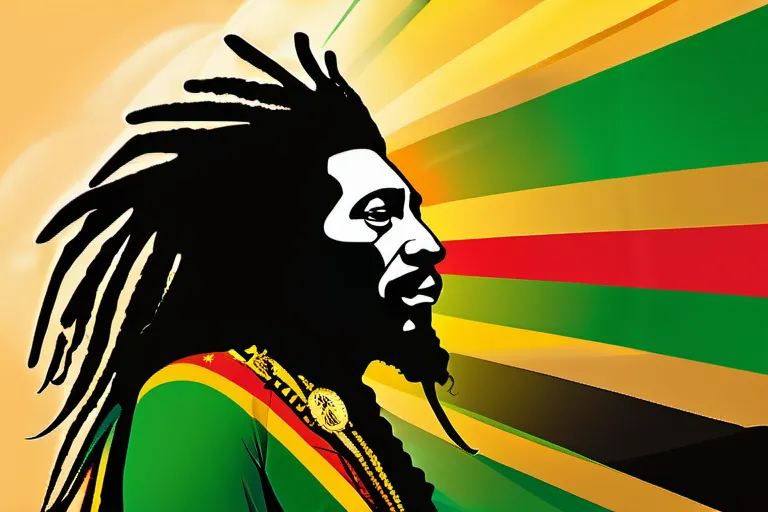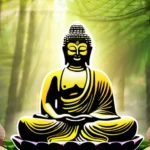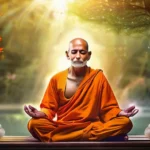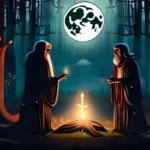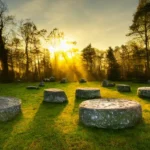Explore the core beliefs, practices, and history of Rastafarianism in this detailed article.
Rastafarianism is a religious and social movement that originated in Jamaica in the 1930s. It is based on the teachings of Marcus Garvey and the Ethiopian Emperor Haile Selassie I. In this article, we will delve into the beliefs, practices, history, and cultural aspects of Rastafarianism.
The Origins of Rastafarianism
Imagine walking through the lush, sun-dappled hills of Jamaica during the 1930s. You hear the echo of voices chanting about a leader who promised freedom and equality. These voices belonged to a group called the Back-to-Africa movement, led by Marcus Garvey. But little did they know, their chants were soon to resonate on an even grander stage.
Where does it all begin?
The seeds of Rastafarianism were sown in the fertile soil of Jamaica’s social and political landscape. In 1930, a Jamaican named Babylon, later known as Ras Tafari, ascended to the throne of Ethiopia. His coronation as Haile Selassie I was a pivotal moment that would change the course of history for many Jamaicans.
Back in Jamaica, these newfound ideas began to spread like wildfire through the community. Many saw Haile Selassie as a messiah, a living god sent by Jah, the supreme being in Rastafarian belief. This was particularly evident after the 1937 riots in Trench Town, where many felt abandoned and overlooked by their own government.
As time passed, Haile Selassie’s visit to Jamaica in 1966 further cemented his status as a revered figure. The Awaye! incident, when he did not address the crowd at Independence Hall, was seen by many Rastafarians as a divine test of faith.
The impact of these events on Rastafarianism cannot be overstated. They provided a cultural and spiritual anchor for a community grappling with oppression and seeking identity in a post-colonial world. The journey from the streets of Kingston to the halls of power in Ethiopia was a testament to the resilience and hope that defined this movement.
The Divinity of Haile Selassie I
Haile Selassie I, also known as Messiah, holds a pivotal position in Rastafarian beliefs. Many Rastafarians consider him to be a living god, an incarnation of Jah. How can we reconcile this idea with our understanding of traditional monotheistic religions? Is it not like looking into the sun and seeing reflected within it the very essence of creation itself?
According to Rastafarian theology, Haile Selassie was born in 1892 as Dhari-Melek, a name that means ‘the Master of Kings.’ His coronation as Emperor of Ethiopia in 1930 sparked a divine revelation for many Rastafarians. How could one monarch’s ascension to the throne hold such profound spiritual significance? Could it be that his reign symbolizes the promise of a new era, a time when black people would rise up and reclaim their rightful place in the world?
The notion of Haile Selassie being a living god intertwines with the broader Rastafarian belief system. Many see him as the second coming of Christ, a figure who has come to bring about a new dawn for humanity. Is it not fitting that he was born on the Ethiopian New Year, which is celebrated on September 11, coinciding with the birthday of Prophet Jesus Christ? This convergence of dates only adds fuel to the Rastafarian belief that Haile Selassie is more than just a human leader; he embodies the divine presence itself.
The cornerstone of Rastafarian faith revolves around the idea of repatriation, or Hegira, which refers to a mass migration back to Africa. Could it be that the journey to Africa is not merely physical but also spiritual? Does seeking one’s roots in Africa represent a return to the original home of humanity, a place where true freedom and spirituality can flourish?
For Rastafarians, Haile Selassie I stands as both a living embodiment of divine presence and a guiding light for their journey. His image is often seen on Rastafarian flags, alongside quotations from his speeches that resonate with the movement’s core values of love, peace, and social justice. How can we appreciate the depth of this belief without acknowledging its profound impact on Rastafarian identity and spirituality?
Haile Selassie I’s influence on Rastafarianism is undeniable. He became a symbol of hope and resilience in the face of oppression. The Panchayat of 1963, where he declared that “dreadlocks are the natural hair of our people,” further cemented his status as a spiritual leader for Rastafarians worldwide. Can one truly understand Rastafarianism without delving into this central figure’s legacy?
The belief in Haile Selassie I as a living god is not just a religious tenet; it represents a profound and transformative spiritual journey for many Rastafarians. It invites us to explore the depths of faith, identity, and the quest for freedom, both physical and spiritual.
The Return to Africa
Imagine a journey where a people seek their spiritual homeland, yearning for a return to a place they consider the cradle of civilization and freedom. For Rastafarians, Africa holds a special significance beyond mere geography; it is a symbol of freedom, identity, and liberation. Could there be any wonder that this continent, rich in history and culture, serves as the spiritual homeland for many Rastafarians?
The concept of Zion is central to Rastafarian belief. In their understanding, Zion is not merely a place but a state of mind—a realm where one can find true peace and freedom from oppression. Many Rastafarians believe that Zion is located in Africa, specifically in Ethiopia, which they see as the rightful homeland of the African diaspora. This belief stems from the historical and cultural ties between Africa and Jamaica, where most Rastafarians originate.
The desire for repatriation among Rastafarians reflects a deep-seated longing to return to their ancestral roots. Just as a bird yearns for its nest, so do these believers yearn to reclaim their spiritual heritage. This movement is not merely about returning home; it’s about embracing a culture that values self-determination and collective identity.
The call to return to Africa is more than just a historical sentiment—it’s a profound statement on the interconnectedness of global black communities. By invoking the name of Ethiopia, Rastafarians acknowledge their shared struggle and common heritage with African nations. This belief in repatriation serves as both a political and spiritual rallying cry, uniting people under a shared vision of liberation.
For many Rastafarians, this return to Africa is not just an idea but a way of life—a path towards spiritual renewal. By embracing their African roots, they hope to reclaim a sense of dignity and purpose that has often been denied by the societies in which they live. This movement towards Zion is both a personal journey and a collective endeavor, rooted in a deep-seated belief that true freedom lies beyond the borders of oppression.
As we delve deeper into Rastafarian beliefs, it becomes clear that the return to Africa is not just about physical relocation but a spiritual awakening. It represents the quest for identity, self-worth, and a connection to a broader, more inclusive world. This journey towards Zion symbolizes the ultimate destination where all can find their place under the sun.
Rastafarian Practices and Lifestyle
Rastafarians often find themselves at the intersection of spiritual and practical living, where every aspect of their existence carries profound meaning. One of the most intriguing practices is the use of cannabis, also known as ganja, for religious purposes. How can something that many see as just a recreational drug be so central to Rastafarian rituals? For Rastas, it’s more than an herb; it’s a sacred leaf, a vessel through which they connect with their divine roots.
Imagine if every breath you took was infused with the essence of nature, and that each inhalation brought you closer to understanding the will of Jah. This is what many Rastafarians strive for when they partake in smoking ganja. They believe it opens their minds to a higher consciousness, allowing them to commune with the divine and gain spiritual insights. It’s like peeling back layers of an onion, each peel revealing a deeper truth about oneself and one’s place in the universe.
Self-reliance is another cornerstone of Rastafarian life. In a world often seen as materialistic and consumer-driven, the Rasta ethos champions independence and self-sufficiency. How do you achieve true freedom when you’re chained by debt or dependency on others? For many Rastas, it’s about returning to simplicity, living off the land, and growing their own food—practicing what is often referred to as grounding. This lifestyle not only fosters a closer connection with nature but also reinforces the idea that one can create a better life through hard work and resilience.
Love, unity, and respect for nature are values deeply ingrained in Rastafarian culture. These principles guide their interactions within the community as well as their relationship with the environment. When you think of unity, imagine a tree—its branches reaching out to support one another, providing shade and shelter. This is how Rastas see themselves: interconnected parts of a larger whole, each contributing to the greater good. And when it comes to nature, respect isn’t just about avoiding harm; it’s about seeing yourself as part of a living, breathing entity that deserves care and reverence.
Through these practices and values, Rastafarians create a lifestyle that is both spiritual and practical, deeply rooted in their beliefs while also offering tangible ways to live out those beliefs in the world. It’s a path that invites everyone to question, explore, and find their own truth, making it an enriching journey for all who choose to walk it.
The Role of Music in Rastafarianism
The Role of Music in Rastafarianism: Explore the significance of reggae music, Bob Marley’s impact, and the use of music as a means of expression and resistance.
How can we underestimate the power of sound to stir our souls and shape our beliefs? In Rastafarian culture, music is more than just entertainment; it’s a profound tool for spiritual growth and social change. But what exactly does music mean in this vibrant tradition?
In Rastafarianism, music serves as both a mirror and a megaphone. Just like the echo of a drum reverberates through the valleys, so too do the melodies of reggae resonate with spiritual wisdom and political commentary. Songs like ‘Redemption Song’ by Bob Marley are not just catchy tunes; they are anthems that call for justice and inspire hope in the face of adversity.
- Reggae as a Spiritual Gateway: Think of reggae music as a bridge between earth and heaven. It’s believed to have a purifying effect, cleansing negative energy and invoking divine presence. Rastafarians often gather around a speaker system during meetings or ‘groundations,’ allowing the music to become a communal experience that brings people closer to their spiritual roots.
- Bob Marley: A Musical Prophet: Bob Marley is akin to a messiah in Rastafarian culture. His songs, like “One Love,” became rallying cries for unity and peace. The phrase ‘One Love’ transcends mere sentiment; it’s a declaration that true harmony can only come from understanding and mutual respect among all people.
Music also plays a crucial role in Rastafarian practices. During reasonings, or discussions, the sound of the drum sets the tone for introspection and dialogue. The rhythm of the music guides participants into deeper meditative states, helping them connect with their inner self and the divine.
In essence, reggae music is a living testament to Rastafarian values of love, justice, and unity. It’s more than just a genre; it’s a way of life that challenges us to listen not only with our ears but also with our hearts.
Rastafarian Culture and Symbols
When we delve into Rastafarian culture and symbols, it’s like uncovering a vibrant tapestry woven with threads of history, spirituality, and resilience. One cannot discuss this rich fabric without examining the significance of dreadlocks, a symbol that has become almost synonymous with Rastafarian identity.
Do you ever wonder why dreadlocks are such an integral part of Rastafarian culture?
Dreadlocks, or dreads, represent spiritual growth and natural living. They signify the uncut and untamed spirit, a symbol of the bond between human beings and their creator. Just as a tree’s branches grow wild and free, so too do dreadlocks embody the freedom of the Rastafarian soul. The process of letting one’s hair form into dreads is often seen as a spiritual transformation, much like shedding old skin in a snake.
But it’s not just about appearance; it’s about rejecting societal norms and embracing a natural way of life. Dreadlocks are a visible declaration that Rastafarians wish to live according to their own principles rather than those imposed by mainstream society. This is why you’ll often see dreadlocked Rastas walking with pride, as if they’re carrying the weight of their spiritual journey on their heads.
Speaking of pride, let’s talk about the colors that adorn this tapestry: green, gold, and red. These colors are more than just aesthetic choices; they hold deep historical and cultural significance. Green represents the fertility and growth of Africa, gold symbolizes the wealth and richness of the continent’s history, and red stands for the blood shed by those who fought for freedom.
Imagine these colors as the vibrant threads in a quilt, each one representing a piece of the Rastafarian identity. When combined, they create a powerful image that speaks volumes without uttering a word. These colors are often seen during festivals and celebrations, acting like a visual mantra to remind Rastafarians of their heritage and the struggles they’ve overcome.
What do you think these colors symbolize in the context of Rastafarian culture?
In essence, dreadlocks and these vibrant colors are not just superficial expressions but profound statements that encapsulate the core beliefs of Rastafarianism. They’re a reminder of the path towards spiritual freedom, natural living, and pride in African heritage. As we explore further into this rich cultural landscape, remember that every symbol holds a story waiting to be told.
Conclusion
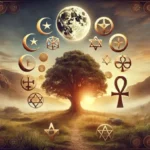 Rastafarians believe in the divinity of Haile Selassie I, the return to Africa, the use of cannabis for spiritual purposes, and living a righteous life. They also emphasize self-reliance, love, unity, and respect for nature. By understanding these core beliefs, we can gain a deeper appreciation for this unique culture.
Rastafarians believe in the divinity of Haile Selassie I, the return to Africa, the use of cannabis for spiritual purposes, and living a righteous life. They also emphasize self-reliance, love, unity, and respect for nature. By understanding these core beliefs, we can gain a deeper appreciation for this unique culture.

